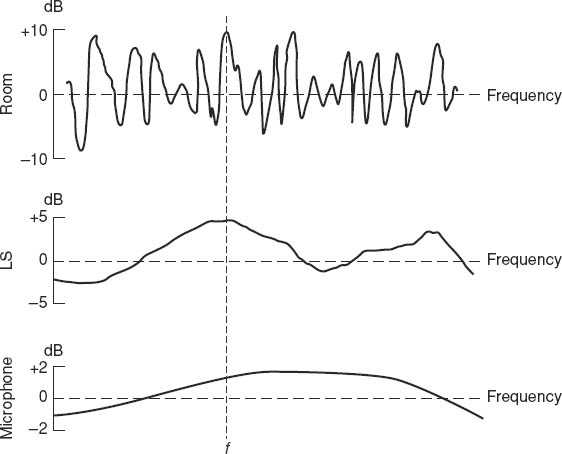12 Public address
Part 2
Howl-rounds
Figure 12.1 shows in diagrammatic form the fundamentals of a PA situation. The amplifier feeding the loudspeakers raises the signal level, while there are losses in the microphone, the loudspeaker and the room itself.
If the gain (amplification) is greater than the total losses then there will be a howl-round. However, if the amplifier is set so that this is not in general the case there can still be trouble if, at any frequency, there is an extra gain caused by the addition of the frequency responses of the main components.
Figure 12.2 illustrates what might be typical frequency responses of the main components in a PA ‘loop’ – the chain which is capable of causing a howl-round. Those components are:
1. The acoustics of the room itself.
2. A loudspeaker.
3. The microphone.

Figure 12.1 A basic PA situation
Figure 12.2 Frequency responses within the PA loop
In the diagram it can be seen that at the frequency f, marked with a dotted line, all three components have a response which is higher than the average. In other words, at this frequency there is in effect additional amplification, by perhaps as much as 15 dB. It is at this frequency that the additional ‘gain’ may result in a howl.
Moving the microphone can create different conditions and the howl may go away, or get worse, or even occur at another frequency! Changing the microphone position is nevertheless worth trying. If the microphone is to remain static, then an equalizer producing a dip in the response at f will almost certainly give a worthwhile improvement.
100-volt systems
This is something of a misnomer as it suggests that the voltage involved is 100; in fact it is only notionally that value. The idea is simply that transformers are used at the output of the amplifier which feeds the loudspeakers to step up the voltage to, conceptually, 100 V. What the voltage actually is depends on the signal at any instant. When the speech, or whatever, is quiet then the line voltage will be much less than 100 V, obviously.
To take a very much simplified example, suppose the amplifier is delivering 10 A at 10 V. A long run of cable to loudspeakers might have a resistance of 1 Ω. But the power produced as heat in a resistance is given by:
P = I2R
where I is the current in amps and R is the resistance in ohms.
Now, with 10 A and 1 Ω, the power lost in the cable will be
(10)2 × 1 = 100 W!
If true, this suggests that all the amplifier's power is lost as heat. Clearly this cannot be the case, but this is a simplified example and what will be true is that a substantial amount of power will be lost as heat in the cables.
The reader will probably be well aware that a transformer which steps up the voltage in a particular ratio steps the current in the same proportion. So if the amplifier's output goes into a transformer which steps the voltage up ten times (in this example to a nominal 100 V), the current will go down by a factor of 10 – from 10 A to 1 A.
The power loss in the cable will now be
12 × 1 = 1 W
– a power saving of 99 W! (Not really this much if the calculation were done correctly, but there will be a substantial saving.)
Of course, there must be transformers in each loudspeaker which restore the voltage and current to values more appropriate for the unit. It is common for these transformers to have variable tapping (the step-up/step-down ratios can be changed) and this means that the outputs of individual speakers can be preset. Even a complex system can then be optimally balanced even though there may be only one power amplifier.
Questions
1. The principal radiation of sound from a vertical column loudspeaker is
a. Wide horizontally, narrow vertically
b. Narrow horizontally, wide vertically
c. Narrow both horizontally and vertically
d. Wide both horizontally and vertically
2. A person is going to speak to a fairly large audience in a hall. PA is needed. Which microphone from the list below is most likely to be suitable?
| a. Omnidirectional | b. Figure of eight |
| c. Cardioid | d. Hypercardioid |

